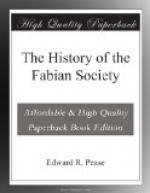Mrs. Besant and the Rev. Stewart Headlam, standing as Progressives, were elected to the School Board in November, 1888, when Hubert Bland was an unsuccessful candidate.
Finally it may be mentioned that a Universities Committee, with Frank Podmore as Secretary for Oxford and G.W. Johnson for Cambridge, had begun the “permeation” of the Universities, which has always been an important part of the propaganda of the Society.
At the Annual Meeting in April, 1889, the Essayists were re-elected as the Executive Committee and Sydney Olivier as Honorary Secretary, but he only retained the post till the end of the year. I returned to London in October, was promptly invited to resume the work, and took it over in January, 1890.
In July another important tract was approved for publication. “Facts for Londoners,” No. 8 in the series, 55 pages of packed statistics sold for 6d., was the largest publication the Society had yet attempted. It is, as its sub-title states: “an exhaustive collection of statistical and other facts relating to the Metropolis, with suggestions for reform on Socialist principles.” The latter were in no sense concealed: the Society still waved the red flag in season and out. “The Socialist Programme of immediately practicable reforms for London cannot be wholly dissociated from the corresponding Programme for the kingdom.” This is the opening sentence, and it is followed by a page of explanation of the oppression of the workers by the private appropriation of rent and interest, and an outline of the proposed reforms, graduated and differentiated income tax, increased death duties, extension of the Factory Acts, reform of the Poor Law, payment of all public representatives, adult suffrage, and several others.




